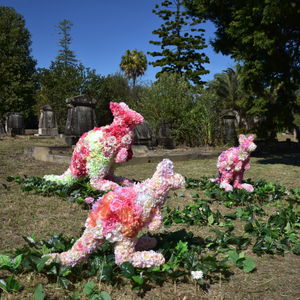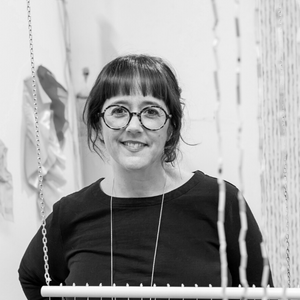Your one wild and precious life (2022)
Artificial flowers and wire

At one point in time, you would have seen kangaroos hopping around Rookwood Cemetery. Now you’ll mostly see foxes and rabbits. Where I live in Bathurst, I still see kangaroos in the paddocks on my early morning walk. I see more on the side of the road when I drive to work, but these ones are dead. On the same stretch of road, there are memorials marking the places where our human loved ones have died. Handmade from artificial flowers, those memorials retain their vitality in the region’s extreme weather, unnatural reminders of our mortality. We don’t mark the places where creatures from the more-than-human world die, there are too many deaths. And besides, they were in our way
About the Artist

Karen Golland lives on Wiradjuri Country in Central West NSW. She works across sculpture, site-specific installation and textiles, and has presented solo exhibitions at Bathurst Regional Art Gallery and Western Plains Cultural Centre. Karen has been curated into group exhibitions including ‘No Show’ Carriageworks; ‘Occupied’ Blue Mountains Cultural Centre; ‘With every breath’ Blue Mountains Cultural Centre; ‘Curiouser and Curiouser’ Bathurst Regional Art Gallery. Karen presented work at Cementa15, and Here and not here, Cementa19, and is currently working as an artist educator at Orange Regional Gallery to develop public programs and workshops. She is a founding member of WAYOUT artist collective in Kandos and was appointed to the Firstdraft Board of Directors in 2021.
Transcription
Hi, I'm Karen Golland. I'm an artist who's based in Bathurst. So the title of my artwork is Your one wild and precious life, which is the name of a Mary Oliver Poem "the Summer's Day", and I guess she uses this phrase from the perspective of the kangaroo, which is one of Australia's most adored and despised creatures. Well, this work has been under development for quite some time now. I think it really started when I was involved in rescuing a swamp Wallaby from the centre of Bathurst. Bathurst has a lot of big car races up at Mount Panorama.
When these races happen there's a lot of dislocated animals in town and this one particular wallaby had found itself right in the centre of Bathurst and it was really sort of hard like I was riding my back home and saw it on one of the corners and sort of stopped to see what I could do. But it was this moment where I realized like, wild animals in the centre of town actually nobody's responsibility. We did finally have one of the local ecologists who has a license to tranquilize creatures came and when he was sort of inspecting the kangaroo to sort of make sure that it was okay, we discovered that there was a wallaby, little joey, in its pouch, which I guess really added this extra layer to my experience of that event considering wallaby as well as a creature in distress really kind of made me think a lot about how all the situations that we put these animals in and they're just, I guess, the result of sort of our human lives.
So I think from there I wanted to kind of make a memorial to the creatures that had disappeared from particularly the very manicured parks and gardens around Bathurst. So I was wanting or doing a lot of research into topiary because I was really thinking it would be nice to make a sort of living, sort of memorial these animals that could be seen in some of the local parks. But I guess, I was also sort of looking around at other ways that humans memorialize or, you know, pay tribute to people who have died and, you know, walking through cemeteries and also living in a regional location, you're often driving on the highways and there's a lot of sort of roadside memorials, and so I started, you know, thinking it might be sort of more poignant, I guess, to make the kangaroos out of artificial flowers, so the same materials that humans used to make tributes, I guess, to our loved ones when they died. Yeah, sort of switched over but kept the sort of topiary kind of ideas. Like the kangaroos aren't necessarily like life size or replicas of what kangaroos look like in the wild. They're kind of a little bit of a caricature, I guess, of a of a kangaroo or sort of that image that we have of them that's really sort of removed from their their lives or what they look like in the wild.
Yeah, I guess that the flowers also then add that sort of really sort of kitsch element to what they look like, which I think is has this extra twist. It's a very sort of sombre kind of memorial to these creatures, but also, you know, somehow more poignant because the artificial flowers don't actually die. So the process really came about, or starts with topiary frame, which there's three of them. So the sculpture, the installation, has three separate kangaroos, like a kind of replicating what like a family, a family, a small family of kangaroos, would look like, I guess, and the frames are then sort of covered with chicken wire, flowers are then hot glued over that existing frame. I've spent a lot of time at Rookwood cemetery and I really walking around those kinds of sites because they're so steeped in human history and, I guess, quite deeply about life and death and your own mortality, but also sort of, you know, consider all of the humans who have also lived on this world.
But I guess I'm also really interested there's so much more history to those sites as well, and one of those histories is the animals or the creatures that used to live there that aren't there anymore, and so the work relates to the cemetery in that way in terms of paying tribute, I guess, or remembering the lives of people who or of creatures who are no longer there in the physical sense and hopefully as well, having been made out of the artificial flowers, they will look like they are meant to be there in some ways there, hopefully even that kind of way that they have been constructed. So I hope that this work, I very much feel that it's come out of a similar kind of thoughtfulness about the death of animals as well. I think what I'd love the viewer to take away IS you know, that same thoughtfulness that we have, or that same kind of way that we have such respect, I guess, or death and the ones that we love. It's such an important part of our lives.
How we remember or we sort of process those griefs, and I think with Kangaroos in particular, but there's a lot of creatures that we as a society like, you know, either kind of label them good or bad, and you know, kangaroos, particularly in the regional setting, and not necessarily always creatures that are dealt with with a lot of respect. I would like to think that we could start to think about all life in a way where we're a little bit more respectful of that or kind of, you know, have that same sense of like loss of life. In that way, hopefully, you know, we become better people and have a better world.